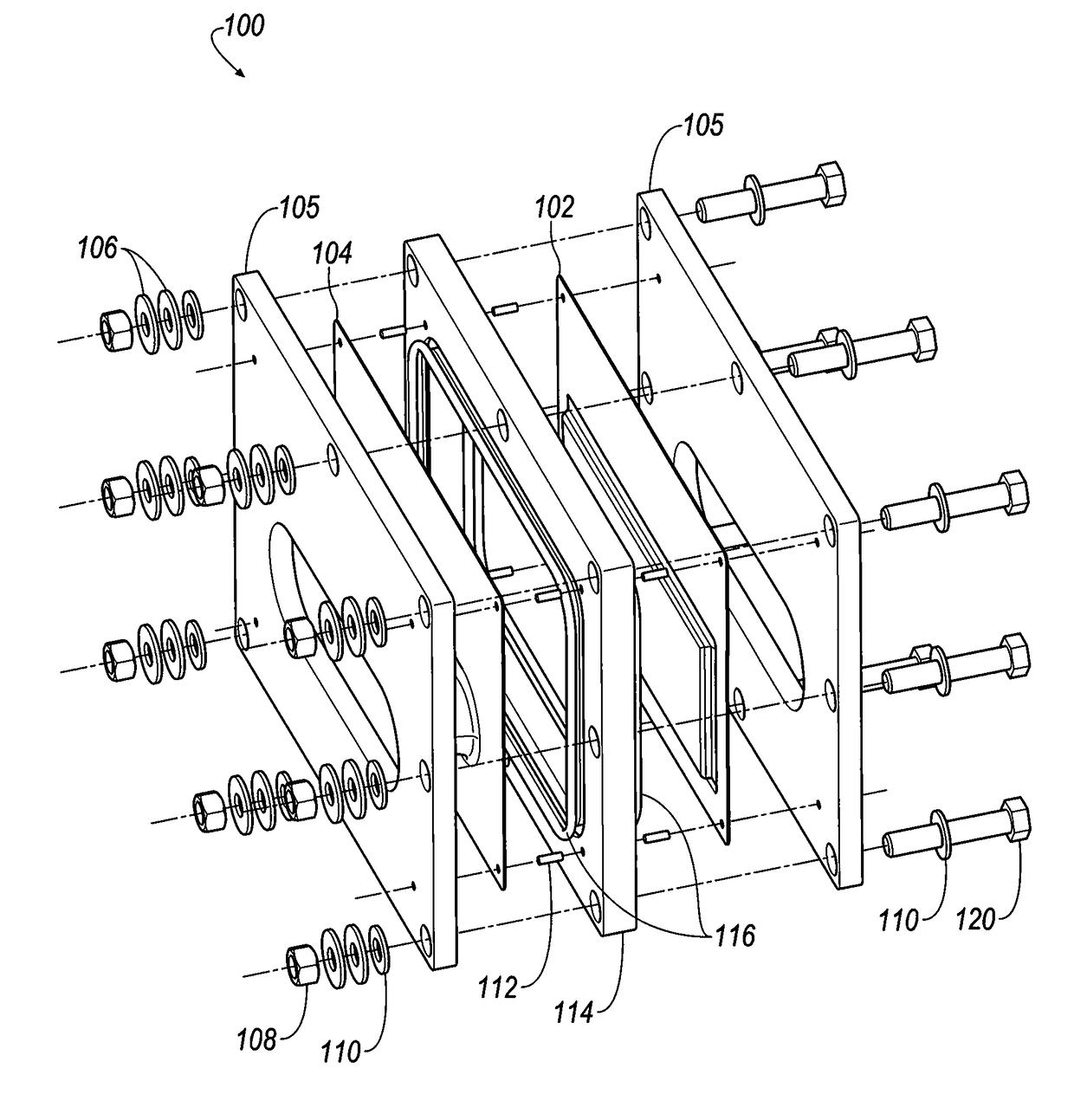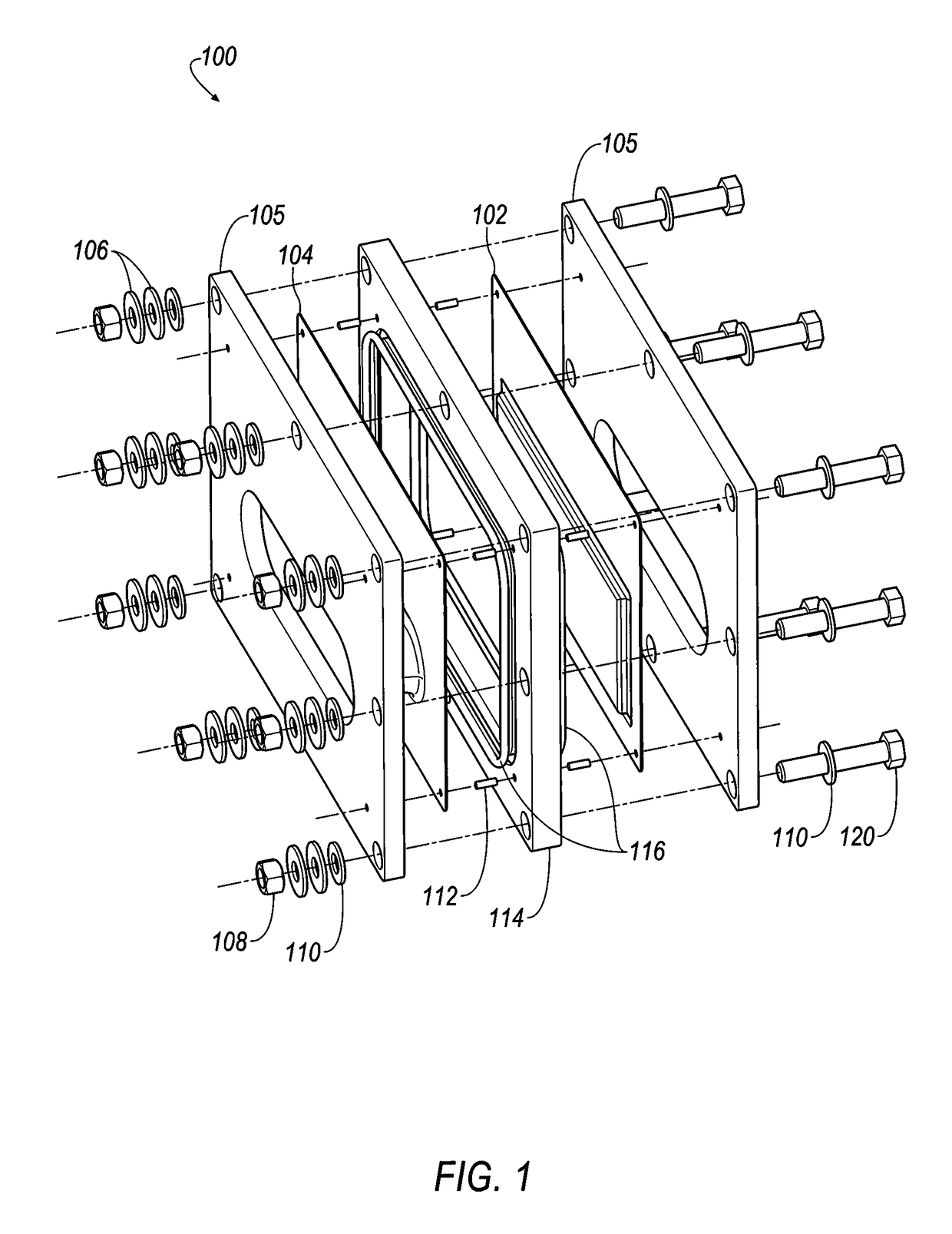Electrolyte for rechargeable electrochemical cell
a rechargeable electrochemical cell and electrochemical technology, applied in the field of electrochemical cells, can solve the problems of high inefficiency of these storage batteries, increase vapor pressure, and reduce the amount of bromide/bromine available, so as to improve the performance of zinc-halide batteries, improve stability and durability
- Summary
- Abstract
- Description
- Claims
- Application Information
AI Technical Summary
Benefits of technology
Problems solved by technology
Method used
Image
Examples
example 1a
e Formulations
[0388]Ingredients used in the electrolyte formulations described below were reagent grade.
TABLE 1Ingredients for electrolyte ingredientsIngredientSourceZnBr2 (73-79% ZnBr2 soln. in water)ICL IP America, Inc., Carteret, NJKBrAlfa Aesar, Ward Hill, MAKClAlfa Aesar, Ward Hill, MAtetraglymeSigma Aldrich Corp., St. Louis, MODME-PEG 2000Sigma Aldrich Corp., St. Louis, MODME-PEG 1000Alfa Aesar, Ward Hill, MAN-methyl-N-ethylmorpholinium bromideICL-IP Bromine Compounds, Ltd.,Beer-Sheva, Israelneopentyl glycolSigma Aldrich Corp., St. Louis, MOtert-butyl alcoholAlfa Aesar, Ward Hill, MASn (SnCl2•2H2O)Alfa Aesar, Ward Hill, MAIn (5% v / v in dilute nitric acid - 10,050 μg / ml)Inorganic Ventures, Christiansburg, VAacetic acid (glacial)Alfa Aesar, Ward Hill, MA18-crown-6 etherSigma Aldrich Corp., St. Louis, MO15-crown-5 etherSigma Aldrich Corp., St. Louis, MOtetraethylammonium bromideAlfa Aesar, Ward Hill, MA1-ethyl-2-methylpyridinium bromideICL-IP Bromine Compounds, Ltd.,Beer-Sheva, I...
example 1b
mical Cells Including Electrolyte Formulations of Example 1A
[0403]Referring to FIGS. 35-38, selected electrolytes, formulated as described in Example 1A, above, were added to dry electrochemical test cells that were evaluated for discharge capacity, Coulombic efficiency, Run Time, and energy efficiency as a function of charge cycle no. The dry cells used in this example were formed as illustrated in FIG. 1. Each of the test cells included a Calgon Carbon Zorflex ACC FM-10 carbon cloth separator that was cut into rectangles (width ˜5.31 cm, length ˜12.076 cm) using a steel ruled die coated in ZrN of the same shape. The carbon material was formulated with 20 kg of PTFE dispersion (60 wt %) (DuPont DISP30 PTFE dispersion), 10 kg Cabot PBX52 carbon blacks, 1 kg carbon fibers (3 mm), 10 kg Akzo-Nobel Ketjenblack EC600JD carbon blacks and 10 kg of de-ionized water. The dry ingredients were premixed in a 55 gallon drum with an anti-static drum liner to form a relatively homogeneous mixture...
example 2
te No. 2-1
[0405]Bipolar Static (Non-Flowing) Cell Testing:
[0406]The following electrolyte formulations were tested in battery stacks, illustrated in FIGS. 18-20.
[0407]Each of the 28 bipolar electrodes of the battery stacks included a Calgon Carbon Zorflex ACC FM-10 carbon cloth separator that was cut into rectangles (width ˜5.31 cm, length ˜12.076 cm) using a steel ruled die coated in ZrN of the same shape. The carbon material was formulated with 20 kg of PTFE dispersion (60 wt %) (DuPont DISP30 PTFE dispersion), 10 kg Cabot PBX52 carbon blacks, 1 kg carbon fibers (3 mm), 10 kg Akzo-Nobel Ketjenblack EC600JD carbon blacks and 10 kg of de-ionized water. The dry ingredients were premixed in a 55 gallon drum with an anti-static drum liner to form a relatively homogeneous mixture to which the PTFE dispersion and de-ionized water were added, and the resulting mixture was stirred to generate a dough material. The dough material was formed from into blocks (length ˜5.24 cm, width ˜3.94 cm,...
PUM
| Property | Measurement | Unit |
|---|---|---|
| wt % | aaaaa | aaaaa |
| wt % | aaaaa | aaaaa |
| wt % | aaaaa | aaaaa |
Abstract
Description
Claims
Application Information
 Login to View More
Login to View More - R&D
- Intellectual Property
- Life Sciences
- Materials
- Tech Scout
- Unparalleled Data Quality
- Higher Quality Content
- 60% Fewer Hallucinations
Browse by: Latest US Patents, China's latest patents, Technical Efficacy Thesaurus, Application Domain, Technology Topic, Popular Technical Reports.
© 2025 PatSnap. All rights reserved.Legal|Privacy policy|Modern Slavery Act Transparency Statement|Sitemap|About US| Contact US: help@patsnap.com



